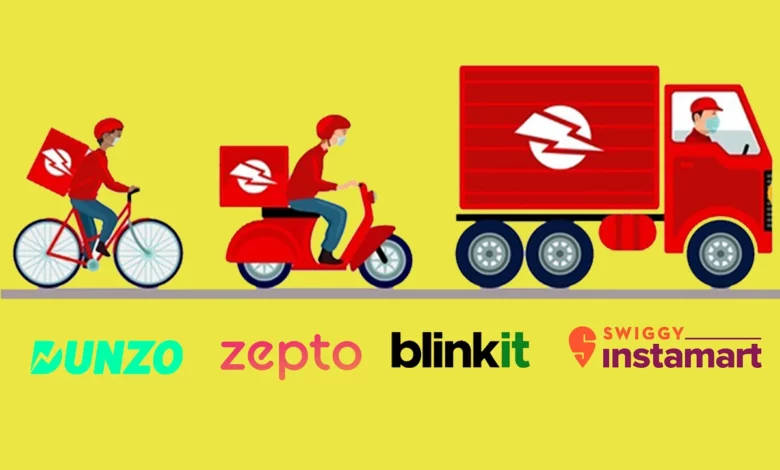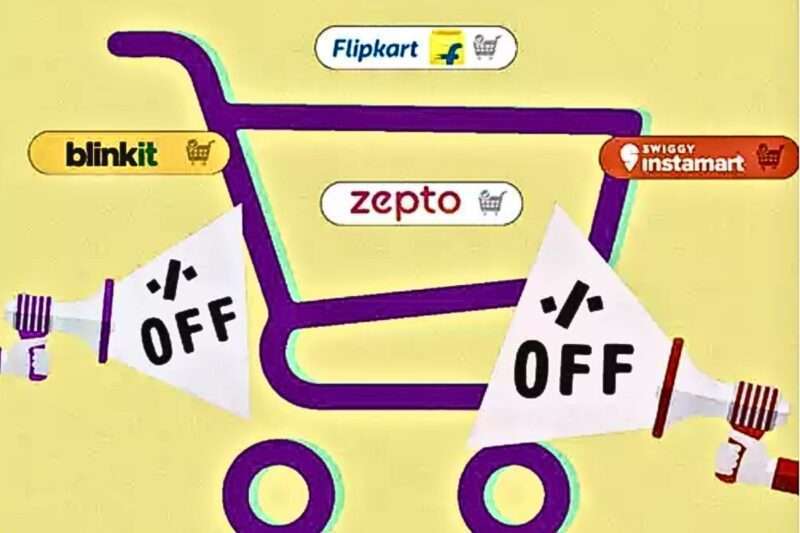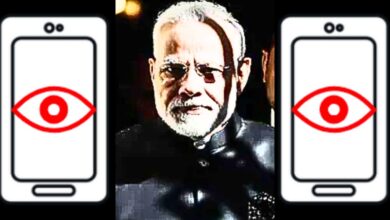Zepto’s Funds Shower: Why Quick Commerce Is The Honchos’ New Magnet, And What Are the Key Factors for Bandwagon Domination?

Zepto– According to reports, Zepto is in talks with investors to raise an additional $400 million at a valuation of $4.6 billion. This follows after Zepto received $665 million from new and existing investors last week, giving it a valuation of $3.6 billion. Zepto’s fundraising drive coincides with its plans to reverse flip to India and go public in 2026. The company is in the process of relocating its domicile from Singapore to India ahead of the IPO, with work already underway.
Swiggy Instamart– Before the expected IPO, Swiggy Instamart’s unit economics continued to improve because of “larger basket sizes, expanded user base and improved operational efficiency”.
Blinkit– Earlier this month, it was reported that the parent Zomato is planning to infuse a fresh Rs 300 crore into its quick commerce unit Blinkit, as per filings made with the RoC, making a total investment of nearly Rs 2,300 crore since acquiring Blinkit in August 2022. Moreover, in April 2024, Goldman Sachs analysts valued Blinkit at $13 billion, which is higher than Zomato’s core food delivery business.
Ola– Ola, a ride-hailing company, is preparing to enter the grocery delivery market. According to reports, Ola plans to provide its services using the Open Network for Digital Commerce (ONDC) platform in the coming days. This is Ola’s third effort at online grocery delivery. They previously created independent grocery stores and a food delivery system alongside dark storefronts, but both were short-lived. With this new initiative, the company will challenge Blinkit and Swiggy Instamart.
Jio mart– Just a few days ago, it was reported that Reliance Retail has begun testing a quick delivery service for groceries and fast-moving consumer goods in some areas of Mumbai and Navi Mumbai to fulfil orders within an hour. Reliance’s quick delivery strategy comes as it competes with startups like Blinkit, Swiggy Instamart, Zepto, and Tata-owned BigBasket’s BB Now, all of which fulfil most orders in within 10 minutes.
Uber– In May 2024, it was reported that Uber, the ride-hailing app, is expanding its hyperlocal deliveries from neighbourhood retailers, according to sources familiar with the situation, as India’s desire for quick commerce grows.
Flipkart– In March 2024, it was reported that Flipkart is planning to launch a quick-commerce service in a few months. Delhivery cofounder and CEO Sahil Barua months ago indicated that a sub-segment of quick commerce, including two- or four-hour delivery, might emerge, with major e-commerce platforms like Amazon and Flipkart joining.
As people are getting busy in their day-to-day lives, from professional duties to personal commitments, there is seen a decrease in regular visits to the nearby Kirana stores. As families in urban regions have better disposable incomes, they are openly accepting the convenience fee as the new norm, and hence, this makes it a quick race for companies to dominate the domain of quick commerce in India. Whether it is existing big players like Amazon or Flipkart, or the new ones like Zepto, be it incoming IPO’s Swiggy Instamart, or the food delivery king Zomato, be it ride-hailing efforts like Uber’s or the conglomerate Reliance’s Jiomart, every player is trying their feat in quick commerce segment.
So, what factors are needed to lead this quick commerce industry?
The quick commerce sector in India is large and rising, with an estimated market value of $5.5 billion by 2025. What’s intriguing is that only three important firms account for the bulk of the market share in this business, and none of them have a typical grocery service provider background. As of January 2024, Blinkit and Zomato had the majority of the quick commerce market share in India. Blinkit had a 40% share, while Zepto’s share was 22%. Instamart, owned by Swiggy, was also a major player in the industry, with a 27% share. Together, these three companies account for more than 80% of the market.
So what’s making them the biggest shareholder of the market? One of the most probable reasons is User Interface.
The user interface.
Certainly, there are several elements that contribute to the top three’s large market share, but having a good user interface is their golden feather. When it comes to navigating through product categories and completing orders, the top three provide an indistinguishable experience based on interface structure and user journey design. Blinkit, Zepto, and Instamart have transformed e-commerce in India. They provide clients with unparalleled speed and ease, allowing them to purchase anything from kitchen supplies to cosmetics. They are probably winning the race due to their seamless user interface and quick delivery.

This conclusion affects both business and design results. For a product trying to enter a competitive market like this, this insight might be one of the most important factors in establishing the product’s commercial and user-centric goals, which will eventually influence the product’s design. If a person wants to try out a new product or switch from one they are already using; they are more likely to do so if the user experience provided is familiar. In this instance, the majority of consumers would choose to use either Blinkit, Swiggy Instamart or Zepto.
Speed.
As the name suggests, Quick Commerce is known for its quick service. Quick commerce’s key value proposition is the ease of on-demand delivery and the rapidity with which customers may get their products, removing the need to wait for typical shipping timeframes. However, speed and timing concerns have mostly gone from the list of parameters to consider. Everyone has virtually worked out delivery times, and customers don’t care if it’s 10 minutes or 20 minutes. Timing is important when comparing 15-20 minute delivery to one-hour delivery. Short delivery times, according to industry leaders, no longer provide an advantage, and platforms will strive to entice customers through price. And this marks the entry of the discounting wars.
The discounting war.
So when everyone is in the same race, one of the ultimate tools to run ahead is the discounting war. For example, remember when Jio dominated the telecom sector by starting with free services. So, after this very recent funding round in Zepto may fuel the discounting war among players.

Now, one can disrupt the market by playing with the cash. When asked to Zepto, they assereted to double their presence across the country, not just in a specific region, and hence are not going to engage in rampant discounting. This is because they believe consumer internet firms have learned time and again that sustainable growth doesn’t come from heavy discounts but from delivering consistent value to the customers. So, whether the other players will indulge in discount wars or not will be revealed in future.
The support of ‘Dark Stores’.
According to an industry source, a quick commerce business generally invests around 3.5% of its average order value (AOV) in dark-store operating costs.
Last month, Zomato said that it would increase the dark store network (warehouses from which items are sent to consumers) of its Q-commerce partnership Blinkit from 526 in March 2024 to 1,000 in March 2025. It further stated that the expansion focus will be on the top eight cities, which include Bengaluru, Mumbai, and Hyderabad. Zepto intends to double the number of dark stores to 700 by March 2025. Swiggy has about 500 dark stores but has yet to disclose any new targets.
The category of products.
The quick commerce which earlier started from basic FMCG elements is now opening its arms to cover other categories also. Quick commerce companies have grown beyond their initial focus on groceries. According to sources, these companies now provide between 8,000 and 10,000 SKUs (stock keeping units), which range from toys, stationery, and even huge appliances.
FMCG firms’ revenue through the channel has nearly doubled, and some of them now see consumers doing their monthly shopping via quick-commerce. In other words, this company is transitioning from small-ticket transactions to larger ones. It’s no surprise that companies like Blinkit, Zepto, and Swiggy Instamart are now vying for a larger portion of the consumer budget by entering the electronics market, selling anything from smartphones to televisions to refrigerators.
Electronics, particularly smartphones, are the main sales category for e-commerce platforms such as Amazon and Flipkart, accounting for about 40% of total revenue, according to industry estimates. Because they are high-value products, they have an immediate influence on quick-commerce revenue and average order values. Furthermore, customers in major cities and younger generations have surpassed the need for touch and feel when purchasing devices and instead prioritise convenience over everything else. As a result, quick commerce companies aspire to become a complementary channel to full-fledged e-commerce platforms like Amazon and Flipkart and are also attempting to break into the electronics market.
Just months ago, Blinkit and Swiggy Instamart began delivering air coolers priced above Rs 5,000, among other high-ticket products. This includes items such as jewellery, game systems, and cellphones. Zepto, based in Mumbai, collaborated with Nasher Miles, a new-age baggage direct-to-consumer company, and Blinkit began distributing Mokobara goods.
The cash is in reserve.
Zomato, which owns Blinkit, has $1.5 billion in cash, while Swiggy’s upcoming IPO will provide it with $450 million in new funding. The new funding rounds of Zepto will be supported in the form of cash reserves.
Karan Taurani, senior vice president at Elara Capital, stated that the fresh cash raised across platforms will be used for expansion due to the segment’s strong growth rate and opportunities. The funds will be utilised to fortify markets in a more profound way because Blinkit is the market leader and is growing market share. The firms will invest significantly in establishing a new range of stores, including working capital, as they grow into areas that demand a lot of it,” Taurani added. Also, it would be in developing technology, convenience, and everything in between. Discounts may have a role, but the three main causes are expansion, technology, and increased product assortments.”

Conclusion.
So as fresh funds are being pumped up in the quick commerce segment and big players are making efforts to enter the market, it will be interesting to see what unfolds in the quick commerce segment.




